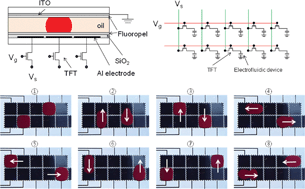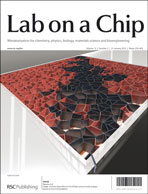Toward active-matrix lab-on-a-chip: programmable electrofluidic control enabled by arrayed oxide thin film transistors†
Abstract
Agile micro- and nano-fluidic control is critical to numerous life science and chemical science synthesis as well as kinetic and thermodynamic studies. To this end, we have demonstrated the use of thin film transistor arrays as an active matrix addressing method to control an electrofluidic array. Because the active matrix method minimizes the number of control lines necessary (m + n lines for the m × n element array), the active matrix addressing method integrated with an electrofluidic platform can be a significant breakthrough for complex electrofluidic arrays (increased size or resolution) with enhanced function, agility and programmability. An amorphous indium gallium zinc oxide (a-IGZO) semiconductor active layer is used because of its high mobility of 1–15 cm2 V−1 s−1, low-temperature processing and transparency for potential


 Please wait while we load your content...
Please wait while we load your content...